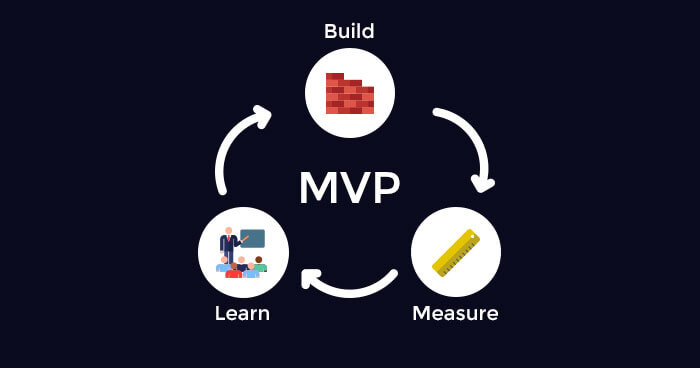
After coming up with a startup idea, the first thing you need is a Minimum Viable Product (MVP) to see if your product will actually succeed in the market.
What is a Minimum Viable Product (MVP)?
An MVP is a development technique popularized by Eric Ries for building a basic version of a product. It envisions that the early adopters can test and provide feedback to improve the product further. Building a minimum viable product can take multiple iterations to reach completion.
Watch the video in which Eric Ries talks about the concept of building MVP.
Why Do You Need to Build MVP for Startups?
Every company starts with a basic working model and then its basic product with limited features. Even Google launched their search engine with a basic HTML page just to test how their users were reacting to it. These MVPs also let startups understand the direction to take by making them realize the problems, and coming up with efficient and effective solutions.
Minimum Viable Product vs Prototype
The misconception is that your product/service design prototype is the MVP. No, It’s Not!
The major difference between an MVP and a prototype is that the MVP is the 1st version of your actual product (with limited features) whereas a prototype is just the first draft of your actual product, and it is discarded after testing.
The diagram below will give you a clear understanding of the difference between them.

Image Source: How to Build an MVP from Spark Solutions
How to Build a Minimum Viable Product (MVP)?
This article will take you through the whole process of MVP development and will also guide you about MVP testing once you have it while highlighting the things you need to look for, while launching an MVP, gauging its success, and coming up with a launch tactic.
Types of MVP Models:
In tech, a usual MVP has any of the three models including piecemeal, concierge, and wizard of Oz. All have different ways of forming a prototype. Let’s see what their actual differences are:
Piecemeal
Piecemeal is a build an MVP model in which the product is made from multiple sources. For example, an aggregator like Groupon. Groupon takes deals from various stores and adds them on its platform. It works as an affiliate and earns a little commission when someone makes a purchase. All the deals are already available on these stores and Groupon hasn’t made any of its own deals. This MVP models is great for startups who want to start faster and with minimal budget.
Wizard of Oz
Wizard of Oz MVP model is for those who don’t have the expertise or the time to make a perfect automated system. Wizard of Oz is basically a fake system in which startups pose as that they have a fully automated system but in reality, they are using human workers to get the tasks done. The model is praised in the startup community because it at least shows if the startup has a feasible business model. Because with a feasible model, the systems can be automated later.
Concierge MVP
Concierge MVP model is just like the Wizard of Oz build an MVP model but where Wizard of Oz hides the working behind the system, Concierge MVP is fairly open in that case. Successful implementation of concierge MVP is ‘Food on the table’ startup. The team behind the startup didn’t have any app or a web-based interface, instead, it interviewed the first few testers, asked them their food preferences, and then provides them a monthly list of recipes and grocery lists for a small subscription.
Also Check: The Complete Guide for Ranking Your Startup in SERP’s
Questions to Ask Yourself While Building MVP
Here is a checklist of the essential questions you should ask yourself before you build MVP.
What problem does it solve?
Every product is built to solve a particular problem. If your product isn’t solving one, there is a problem with it and it will eventually fail. The best way to find out if a product will survive in the market is by doing multiple tests.
What is its target market?
Every product is catered towards a targeted market. For example, Snapchat was initially geared towards teens who wanted to send each other vanishing messages. This was also the unique selling point (USP) that led to its fame. So, deciding a target market from the start is crucial in a business aspect.
In fact, Quick Sprout says that 42% of the startups fail because they don’t have a target market.
Is it Scalable?
The term ‘scalability’ is a double meaning term. Venture capitalists will ask you if your product is scalable when you go for pitching, but scalability actually depends on two factors. So, mark these on your list to ask before you build MVP.
Manufacturing cost and return.
Will you be lowering the manufacturing cost, or will that increase with scaling? Because if the cost increases than there is no need to scale the product. This also depends on the type of product you are going to launch. If it is a mobile app or an IoT device scaling, it only requires the addition of a few more servers so all the data can be handled easily. But if it is an ecommerce store, when you scale… let’s say add a new warehouse, the expense for managing that will also increase.
Here is a linear representation of both types of scaling in a startup business.

Graph depicting scalability of a service based startup. Expense and ROI, both remain parallel.

Graph depicting the scalability of a product based startup. The expense gradually decreases.
Source of both pictures: Fortune magazine
Does it have a well-designed UX?
There is a saying, ‘simplicity is the ultimate sophistication.’
So, keep your product simple. You don’t have to worry about UX from the start. Just make sure it is understandable, so the user can navigate easily from the start to the intended point.
A better way to go about it is to get it tested, first from your own team and then by beta testers.
This Might Help: Customer Acquisition Strategies For Your Startup Growth
Factors to Keep in Mind when You Build an MVP
Here’s a list of factors you need to pay heed to successfully build MVP.
Identify Your Success Criteria
This might look obvious, but most CEOs don’t have set success criteria.
What actually success means for a startup?
Define it in a countable format so that you can calculate the ROI. Make a long-term goal and not just for the MVP because once you are through the whole MVP process.
Ask yourself: why am I making the MVP? What is my business model?
If you are making an app. The success criteria should be to get at least 1000 paying users by the end of the year.
Determine the End Goal of the User
Let’s suppose you are making a photo editing app. The users want to edit the photo by using filters. Now map the user journey from A to Z to understand how the interaction will flow. This will help you know how many steps the user will take to and how you can minimize them, therefore adding more value and prioritizing tasks.
Answer All the Pain Points
The only reason you are going through all this effort is that you want to solve a problem that was bugging users and then to build a sustainable business around it.
So, clearly answer all the pain points while building the design and afterward shape your MVP around it.
Prioritize the Features of MVP

Source: Quora
An MVP is not the final product that you will be bringing to the market. So, don’t focus on adding everything to it. Just start with the essential features, without whom the product won’t work. Only try to answer the pain points and you will have a feature-rich MVP ready.
If your product looks simple but solves the problem then go for it.
What’s next after building MVP?
Now as you have created your MVP, what should you do to market your product without failing?
The answer is to test your MVP! Validate your business idea to understand that it meets the startup requirements and that it solves the purpose of its existence. To know that, gather feedback and see if it can be scaled. Because if the product cannot be scaled, it won’t be suitable for the larger customer base.
You will also have to find a market for your product so that it can transition from MVP to Minimum Marketable Product (MMP) smoothly.
MVP Testing Practices
Here are some simple ways to test your product idea in the market and get reliable data to understand how much you need to alter it further.
1. Ask for feedback
Getting feedback is essential for your startup product. It will help you understand how your customers are perceiving your product. There are two ways to get feedback, either get the feedback from a select few people of your choice – also called alpha testing. The second way is to get feedback from actual people.
Matt Warcholinski of COO at brainhub.eu provides some great ways to find people who will be willing to provide feedback. He says just go out in the streets and talk to people about your product. You can also find them on twitter and facebook and ask them if they will be interested in trying your product. You can also offer them future discounts on trying your product.
Further, post about your product on Product Hunt, Hackernews, and social media websites to get early traction and feedback.
2. Show your product to the visitors
You can also test your MVP idea by showing the product directly to the visitors. Do this by adding a landing page to your website. Speak your prospective customer’s language so they know what type of product it is.
Landing pages are often misused as lead generation pages, but they can be used for product testing as well because they provide the relevant data that the founders are looking to make the startup better.
Hint: Add heatmaps to your website to understand user behavior while testing the product.
3. A/B test
One major problem that startups face is that they assume the product they have created is perfect for their customers. Reason? Assumptions can be wrong.
While creating a product that provides value is great, but to provide it traction, startups will have to make the brand enticing. This is only possible by testing different layouts.
4. Performance marketing
When you launch a product, the first thing you want is to get users to test it so that you know first-hand if the product is going to be a success or not. Performance marketing lets you just do that. Instead of waiting months to get your products ranked on search engines, you can directly pay search engines and social media websites to get users to test the products.
Nanxi Liu of Enplug says on his blog ReadWrite.com, you can even use forms so the users can provide specific details about your website. Like, what the worst are things, what the best things are, and what new things should be added.
5. Fundraising sites
Do you know why crowdfunding sites like Kickstarter and Indiegogo took off? Because startups use them to test their products. Just visit any featured product on these websites and you will see that a huge crowd is ready to throw money on the products that aren’t even released yet.
If you have a hardware product and want to test its feasibility. Make an explainer video and let the crowd funders decide if your product is worth marketing.
6. Explainer video
According to Dream Grow, more than 80 percent of businesses believe that having a video can get them more ROI. With sites like Youtube, Dailymotion, and multiple others available, spreading your video is not a problem. In fact, for startups, having an explainer video on the landing page, on social media pages, and on crowdfunding sites can help boost the product testing process.
7. Pre-order pages
Pre-ordering products is a great idea to validate your startup’s product. You can set up a landing page with an explainer video on your website and promote that page through Facebook or Google to get instant feedback from users.
Oculus Rift, the virtual reality gaming glasses, was also launched through a pre-order page by Facebook. This allowed the company to understand if users were interested in the product. The pre-order pages are similar to crowdfunding, but instead of asking the crowd to just fund your product, you are asking them to buy it.
8. Build worth with blogs
Finally, whether your MVP is digital or hardware, you need to market it thoroughly through blogs. Blogs can be used in multiple ways, such as promoting the product, letting potential customers understand how it works or providing its use cases.
Final Words
We hope this article has helped you learn more about the minimum viable product’s planning process and factors that are necessary to make it a standout and you have also learned that MVP testing is a crucial part of the product launching process. You don’t want to spend time working on a product that isn’t fruitful, so try to use multiple MVP techniques to test if the product fits the market needs.
If your startup’s MVP is ready and you are considering to launch then become a part of our Startup Program and take your startup to new heights with personalized mentorship and extended support.
Arsalan Sajid
Arsalan, a Digital Marketer by profession, works as a Startups and Digital Agencies Community Manager at Cloudways. He loves all things entrepreneurial and wakes up every day with the desire to enable the dreams of aspiring entrepreneurs through his work!


